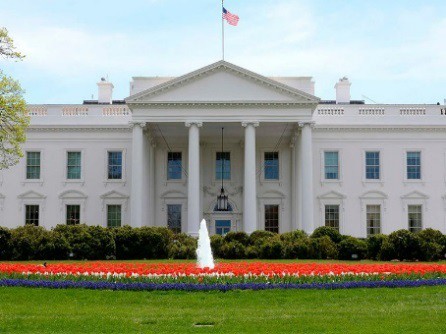[vc_row][vc_column][vc_column_text]
January 2017 Market View
2017: A Year of Political Change – A Year for Investment Selectivity
 The 115th Congress is now seated and the new Administration will take office in several days. Whether you personally supported Trump or Clinton is not a concern to the financial market, or to your investment portfolio. Economic growth, capital flows, and returns on investment respond to fiscal and monetary policy, not our personal political preferences. As investment managers, it is our job to set aside personal preferences and analyze how fiscal and monetary policies impact our opportunities. With Trump’s election, there is no doubt in our minds that we are embarking on a period of significant fiscal policy changes in the United States – changes that will produce attractive opportunities and require acute selectivity as we position to capture income and capital gains in 2017.
The 115th Congress is now seated and the new Administration will take office in several days. Whether you personally supported Trump or Clinton is not a concern to the financial market, or to your investment portfolio. Economic growth, capital flows, and returns on investment respond to fiscal and monetary policy, not our personal political preferences. As investment managers, it is our job to set aside personal preferences and analyze how fiscal and monetary policies impact our opportunities. With Trump’s election, there is no doubt in our minds that we are embarking on a period of significant fiscal policy changes in the United States – changes that will produce attractive opportunities and require acute selectivity as we position to capture income and capital gains in 2017.
Since the financial crisis of 2008-2009, the executive and legislative branches have emphasized the use of monetary policy to stimulate economic growth. The Fed’s “Zero-Interest-Rate-Policy”and its balance sheet expansion to over $4.2 trillion were the main drivers of that growth. Those monetary policies produced sub-par growth however – there was no year among the last eight that produced greater than 3% growth in U.S. gross domestic product.
In our view, slow economic growth, under-employment, trade deficits, and a growing regulatory burden on business created a fertile ground for Trump’s ascendancy. He won the Electoral College due to economic weakness primarily in the upper Midwestern states, a region suffering from years of decline in manufacturing, assembly and mining. Thus, it is no surprise that we see the new president focusing on policies to revive the economic prospects of the region, which we believe will impact the nation as a whole – producing winners and losers.
Fiscal Policy Changes & Impact
Trump’s focus on lowering the corporate tax rate from 35% to 15% is the fiscal policy change likely to have the largest macro-economic impact, in our view. Whether Congress lowers the rate to 15% as Trump proposes, or some other rate slightly above 15%, the change is likely to provide enormous incentive for U.S. corporations to expand domestic operations, and move offshore operations back to the U.S. It is also likely to incent foreign businesses to expand their U.S. operations, or relocate their foreign operations to the U.S., in order to directly serve our large domestic market of over 330 million people.
By most estimates, there are over $2.5 trillion in U.S. corporate assets offshore, with a large percentage held in cash. At the current corporate tax rate of 35% (the highest in the developed world), there is little incentive for that cash to be brought back to the U.S. Trump has proposed a “tax holiday” of sorts for U.S. corporations to repatriate that cash, creating a new10% tax rate for its return to the U.S. According to Stephen Moore, an economist formerly with the Heritage Foundation who now advises Trump, perhaps $1.0 trillion or more in cash could be repatriated at the 10% rate, providing at least $100 billion to the U.S. Treasury. The remainder of that cash could be redeployed into the U.S. for purchase of plant & equipment, hiring of additional employees, mergers & acquisitions, payment of larger stock dividends and stock buy-backs.
As has been widely reported, the most immediate spending policy change that Trump and Congress is pursuing is the repeal and replacement of the Affordable Care Act. Setting politics aside, economists generally agree that repeal of the ACA is likely to have a stimulative macro-economic effect by (1) eliminating the special tax of 3.8% on income, (2) helping small business hire permanent employees – as they will no longer be incentivized to use part-time employees to stay under the 50 employee rule to avoid being subject to the Act, and (3) injecting at least an additional $3 billion into the U.S. economy in 2017 (the amount 3.5 million taxpayers paid in fines to the Treasury in 2015 for not complying with the Act).
As President-elect, Trump has continued to threaten tariffs, or a 10% “border adjustment tax”, targeting U.S. corporations who move manufacturing/assembly operations to Mexico seeking to lower their cost of production, and then selling goods back into the U.S. While the president has wide authority to negotiate trade and impose tariffs, it is unclear at this point whether Trump’s tweets and threats are opening negotiating positions designed to impact corporate behavior, or serious policy changes in the offing. Economists generally agree that a border adjustment tax would not be fully offset by changes in U.S. exchange rates, and would also likely put further upward pressure on the U.S. dollar. A border adjustment tax would give U.S. domestic producers a competitive boost, while disallowing deductions for imports – a blow for retailers and automakers in particular, given the high import component in their supply chains. A stronger dollar would also be a negative for emerging market economies that are already feeling the effect of a sharp rise in dollar-servicing costs and weakness in their own currencies.
Finally, the new Administration has Federal regulations in their cross-hairs. Since the election, pro-business think tanks in Washington have been hard at work identifying low-hanging regulations ripe for repeal. The American Action Forum’s “Top 10” regulations for repeal total $31 billion in savings to business, including nearly 19 million paperwork hours needed to comply. Other groups say there are over $40 billion in regulations that could be easily repealed, as there are now more than 174,000 pages in the Code of Federal Regulations – a stack of paper over 24 feet high!
A Strong Dollar, With Interest Rates and Crude Oil in Trading Ranges
 We expect the dollar to trend higher this year as Japan and Europe continue their QE (quantitative easing) programs. Last month Mario Draghi announced that the ECB would continue printing Euros after March (the original ending date), reducing the rate from 80 billion Euros per month to 60 billion Euros per month thru the end of 2017. Combine that with forced immigration and rising nationalism which threaten the continuance of the European Union, we would expect the Euro to continue declining if those were the only concerns. Add a stronger U.S. economy with higher interest rates and we see it possible that the Euro will drop further, perhaps reaching the 85 to 95 cent level sometime in 2017. Start planning those European vacations!
We expect the dollar to trend higher this year as Japan and Europe continue their QE (quantitative easing) programs. Last month Mario Draghi announced that the ECB would continue printing Euros after March (the original ending date), reducing the rate from 80 billion Euros per month to 60 billion Euros per month thru the end of 2017. Combine that with forced immigration and rising nationalism which threaten the continuance of the European Union, we would expect the Euro to continue declining if those were the only concerns. Add a stronger U.S. economy with higher interest rates and we see it possible that the Euro will drop further, perhaps reaching the 85 to 95 cent level sometime in 2017. Start planning those European vacations!
It is the stronger dollar that will likely keep a lid on long-term interest rates. The 10-year Treasury Bond ended the year just under 2.5%. We expect it to range between 2.25% and 3% this year, but as rates rise and the dollar strengthens, we believe overseas investors will want to avoid currency losses at home. To do that, they will buy dollars. We see that influx of foreign investment keeping the dollar stronger and the long-term rates low. So, whether the Fed raises rates two – four times this year, it will marginally effect the strength of the dollar, but should have very little effect on mortgages or other long-term rates.
You might remember“Greenspan’s Conundrum”. In 2000, Federal Reserve Chairman Alan Greenspan sought higher long-term interest rates. Consequently, he raised the Fed Funds rate numerous times, from 1% to 5.5%. To his surprise, the 10-year Treasury bond refused to rise, as investors believed 5.25% for ten years was more attractive than 5.5% for a short period. Today the Fed rate is less than 0.75%. If the Fed raises the Fed Funds rate three times at 25 basis points each, the rate will still be less than 1.5% – a far cry from Greenspan’s 5.5%.

The recent strength in crude oil due to OPEC/NOPEC’s agreement on production cuts is likely to be capped by a plentiful and readily available supply of domestic production. Fracking and horizontal drilling are now mature technologies whose costs have come down, allowing domestic producers a lower break-even cost and speedy time-to-market. The U.S. is now nearly energy independent. We see West Texas Intermediate crude oil establishing a high around $60 barrel and a low of $40 barrel. Prices below $45 barrel are likely to stimulate marginal demand in our view, while those above $55 barrel are likely to stimulate our marginal U.S.supply – thus a $40 – $60 per barrel trading range.
U.S. Stock Market: Attractive Valuations, But A News-driven First Half
Earnings for 4Q’16 are starting to be reported. Wall Street estimates that when all earning are in, S&P 500 companies will report a total of $118 in earnings per share for 2016. On December 30, 2016 the S&P 500 Index closed at 2,239, which is 18.9 times the estimated $118 of earnings. 18 times earnings is roughly the mid-point of the market’s 25 year historical range of valuation. For 2017, the Street consensus is $132 of earnings per share for the S&P 500. Assuming that the market multiple remains constant at 18 times, this produces a 2017 year-end target of 2,376, or a gain of about 6% for this year. The high estimate on the Street for 2017 is $140 in S&P 500 earnings. Again, assuming 18 times, this produces a target of 2,520 or 12% return for the year. Our view is that if the bulk of Trump’s proposals are enacted, and if investor sentiment improves even more (producing yet a higher market multiple), there is an outside chance for 2,600 to be reached on the S&P 500, or a gain of 16% for the year.
Admittedly, a 6% to 16% gain in the S&P 500 for 2017 is a wide range, but there are also a wide range of fiscal policy outcomes and a wide range of other factors this year – international capital flows, geo-political events and investor sentiment are three. No market advances in a straight line and we see the potential for news-driven market volatility, particularly in the first half of 2017. During that time, the politicians in Washington will be debating the merits of significant policy change, Mr. Trump is likely to keep exercising his Twitter account, and Europe will make important decisions on the future of their monetary union.
Selectivity: Themes – With Sectors to Favor and Avoid
In sum, we see accelerating U.S. economic growth this year, a strong U.S. Dollar, with interest rates & crude oil locked in trading ranges. The U.S. stock market’s valuation is attractive to us, given the estimated earnings and multiples in the mid-range. We do believe, however, that along with sensitivity to news-driven volatility in the first half of the year, sector selectivity will be key to success.
We favor:

- Infrastructure – as Trump and both parties are likely to agree on a package of funding for upgrading the nation’s transportation network and energy grid
- Financials, especially regional banks and asset managers – as there is a move to unburden banks from excessive regulation, higher interest rates improve their net margins, and higher equity valuations and returns drive higher fees
- Semi-conductors – as the content of silicon in our lives continues to increase, whether in our automobiles, communication devices or entertainment
- Defense contractors – as tensions are likely to remain high in the Middle & Far East, and political pressure is exerted on allies to bear a higher burden of their defense costs
- Energy & basic materials – especially natural gas pipelines, shipping and processors, as the U.S. becomes a net exporter and infrastructure spending & regulatory change stimulates demand for iron ore, copper and coal
- Online retail & consumer discretionary – as economic growth accelerates, consumers anticipate lower personal income tax rates and overall sentiment continues to improve
- Small-capitalization companies – due to their attractive relative valuation
We’re avoiding:
- Pharmaceuticals –until we gain more clarity on the pressure to be exerted on pharma prices due to Medicare drug price negotiation and ACA is repealed/replaced
- Mall-based retailers – as the move to online retail continues to eat away at their market share and they continue to reduce their brick & mortar footprint
- Multi-nationals – with large export revenue who are likely to be hurt by the strong U.S. Dollar
- Bond funds – especially municipal bond funds, that will be pressured by higher interest rates and lower personal income tax rates
The Bull Market is Young, Not Old
Have you heard someone say “this bull market is getting long-in-the-tooth” or some other reference to the age of the bull market? Bull markets do not die of old age. They can die for many reasons, among them: high interest rates, high unemployment and economic slowdown. The standard time definition of a bull market is very restrictive – that a bull market continues until the market closes at least 20% below the previous high. On Oct. 4, 2011 the market was down intra-day over 20% from the previous high, but closed at just under -20% that particular day. So, by this restrictive definition, the bull market continued. There was another 19% decline that did not qualify either. Then there was the period from May 2015 through October 2016 when the market chopped sideways, going nowhere for a year and a half. Oddly, by definition, that choppy period does not end a bull market either. In fact, if the market had gone sideways for twenty years, by definition, the bull market would still be intact. Bottom line: if a bull market’s old age is a concern, then this one’s youth should be encouraging. We believe this bull market started in November.
We also occasionally hear that because the stock market is near an all-time high, we should raise cash. Sometimes we hear that we should wait for a deep correction to invest. We see the market near all-time highs as encouraging. With a growing economy and some inflation, we would expect markets to advance, creating new all-time highs just as the U.S. gross domestic product continues to reach new all-time highs. Investors do themselves a favor by forgetting about Dow 20,000 and focusing on Dow 40,000. With 3.5% GDP growth and 3.5% inflation, a 7% annual total, the Dow should reach 40,000 in approximately ten years. If taxes are meaningfully lowered and regulations are meaningfully reduced, that level may be achieved even sooner.
Our Research Process, Starting with the 30,000 Foot View
 Our research process starts with a “30,000 foot view” of the world’s currency movements, money flows, interest rates, and fiscal & monetary policies. We then incorporate industry sector developments, secular trends, and news events. Finally, we employ numerical earnings estimates & models, fundamental company analysis and price trends to help us select individual opportunities. We’re focused on numbers and facts, not opinions.
Our research process starts with a “30,000 foot view” of the world’s currency movements, money flows, interest rates, and fiscal & monetary policies. We then incorporate industry sector developments, secular trends, and news events. Finally, we employ numerical earnings estimates & models, fundamental company analysis and price trends to help us select individual opportunities. We’re focused on numbers and facts, not opinions.
In the end, we seek to design a portfolio that meets your individual goals, incorporating your unique tolerance for risk and particular situation. To that end, this quarter we will be circling back to you to update our records. Expect to receive a questionnaire from us soon; it will help us stay apprised of your goals and risk tolerance. In the meantime, thank you for being our client. As always, if you have any questions about your portfolio or our outlook, please do not hesitate to contact us.
The Beck Capital Team
January 13, 2017
https://www.facebook.com/BeckCapitalManagement/
Please feel free to forward this to friends who you believe might be interested.
All rights reserved by Beck Capital Management LLC.
If you would like to receive a copy of our Privacy Policy or Form ADV, Part II brochure, please let us know and we will be happy to provide it to you.
Investment advisory services offered through Beck Capital Management LLC, a registered investment adviser.This material represents an assessment of the market and economic environment at a specific point in time and is not intended to be a forecast of future events, or a guarantee of future results. Forward-looking statements are subject to certain risks and uncertainties. Actual results, performance, or achievements may differ materially from those expressed or implied. Information is based on data gathered from what we believe are reliable sources. It is not guaranteed as to accuracy, does not purport to be complete and is not intended to be used as a primary basis for investment decisions. It should also not be construed as advice meeting the particular investment needs of any investor. Past performance does not guarantee future results. Nothing contained herein is to be considered a solicitation, research material, an investment recommendation or advice of any kind. The information contained herein may contain information that is subject to change without notice. Any investments or strategies referenced herein do not take into account the investment objectives, financial situation or particular needs of any specific person. Product suitability must be independently determined for each individual investor. Beck Capital Management explicitly disclaims any fiduciary responsibility or any responsibility for product suitability or suitability determinations related to individual investors, as may relate to the information contained herein.”
]Disclosure: Nothing contained herein is to be considered a solicitation, research material, an investment recommendation or advice of any kind. The information contained herein may contain information that is subject to change without notice. Any investments or strategies referenced herein do not take into account the investment objectives, financial situation or particular needs of any specific person. Product suitability must be independently determined for each individual investor. Frank Beck & Beck Capital Management explicitly disclaims any responsibility for product suitability or suitability determinations related to individual investors. The investment products discussed herein are considered complex investment products. Such products contain unique risks, terms, conditions and fees specific to each offering. Depending upon the particular product, risks include, but are not limited to, issuer credit risk, liquidity risk, market risk, the performance of an underlying derivative financial instrument, formula or strategy. Return of principal is not guaranteed above FDIC insurance limits and is subject to the creditworthiness of the issuer. You should not purchase an investment product or make an investment recommendation to a customer until you have read the specific offering documentation and understand the specific investment terms and risks of such investment.
This material represents an assessment of the market and economic environment at a specific point in time and is not intended to be a forecast of future events, or a guarantee of future results. Forward-looking statements are subject to certain risks and uncertainties. Actual results, performance, or achievements may differ materially from those expressed or implied. Information is based on data gathered from what we believe are reliable sources. It is not guaranteed as to accuracy, does not purport to be complete and is not intended to be used as a primary basis for investment decisions. It should also not be construed as advice meeting the particular investment needs of any investor. Past performance does not guarantee future results.
